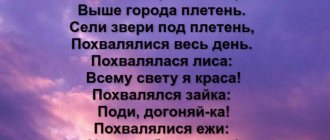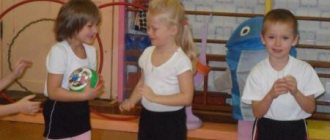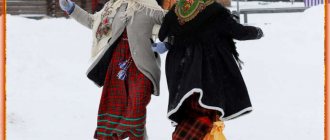MAGAZINE Preschooler.RF
Master class for teachers “Russian folk games”Developer: Music director Galina Nikolaevna Uskova MBDOU kindergarten No. 20 “Zemlyanichka” Kstovo, Nizhny Novgorod region
Purpose of the master class: Transfer of experience in organizing and conducting folk games with children to the participants of the master class.
Objectives: Dissemination of pedagogical experience in promoting folk games; improving the professional skills of teachers participating in the master class.
Folk games for children are works of folk art, original customs and traditions. What are the benefits of folk games for children? This is not only a distraction from the worries of the day, relaxation and entertainment. The folk game for children also has additional meaning. It introduces people to the culture and forms affiliation with it. And although in our information, technological age, folk games for children have almost been replaced by computer games, you need to play them with your child. At home, at school, on the playground, in the yard, on holidays, on a walk in kindergarten, etc. Folk games for children, for the most part, are collective games. Thanks to them, the child learns to communicate in a team, negotiate, follow general rules, feel like he belongs to a group, and through play, to a people, a nation. Games are an integral part of the culture of every nation. They have been created over the centuries and accompany the daily lives of children and adults. They helped and still help physical development (endurance, strength, agility are developed, the formation of personal qualities (a sense of responsibility, self-control skills are cultivated).
Outdoor folk games for children are the most valuable means of comprehensive education of a child’s personality. The task (of parents, teachers) is for children to have the opportunity to touch the rich heritage of Russian culture, to experience the joy of it, to feel national identity, to comprehend the originality of the Russian national character, its wonderful original qualities through the example of folk games.
An attractive aspect of organizing games in preschool educational institutions is that they do not require special gaming equipment. The purpose of folk games is to implement an entertainment function: jokes with funny movements and gestures, which are characterized by simplicity and harmlessness. They determine the pedagogical value of games for a child.
Russian folk games for children
The players stand in a circle. Using a counting rhyme, a driver is selected, he receives a stick and stands in the middle of the circle. An adult puts a beautiful cap on his head so that it reaches his nose. Children, holding hands, run in a circle and say: “One, two, three, four, five - the stick will knock . At this time, the driver knocks the stick on the floor. With the last word, the children stop, and the driver extends the stick towards the children. The one to whom the stick points takes hold of its end and calls the driver by name, and he guesses who called him. The game continues with a new driver.
1. Round dance game “Dudar”
Children stand in a circle, choose the leader - Dudar and, holding hands, walk in a circle and sing: “Dudar, Dudar, Dudarishche,
Old, old, old man.
Put it in the deck
It's raw
Rotten him."
After singing the song, they ask:
“Dudar, Dudar, what hurts? "
Dudar answers: “Leg” (or ears, arm, back, neighbor’s nose, neighbor’s heel, etc.)
Everyone in the round dance takes hold of the neighbor’s sore spot, which Dudar said, and again walks in a circle. Do this 3-4 times, after which to the question “What hurts?” , Dudar replies: “Healthy! . " Everyone runs away, and whoever gets caught takes his place.
2. Game "Zarya"
The players form a circle, hold their hands behind their backs, and one of the players, the charger, walks behind him with a ribbon and says:
- Zarya - lightning, red maiden
I walked across the field, dropped my keys,
Blue ribbons, entwined rings - she went for water!
With the last words, the driver carefully places the ribbon on the shoulder of one of the players, who, noticing this, takes the ribbon, and they quickly run in different directions in a circle and try to take an empty seat. Whoever is left without a place becomes the dawn.
3. Game Golden Gate" 1st option.
The two leaders receive names - “moon” and “sun” . They stand facing each other and, joining their hands, raise them up, forming a collar. The rest of the players, holding hands, pass through this gate. The players representing this gate sing:
Golden Gate,
They don't always miss.
The first time - goodbye.
The second time is prohibited,
Well, for the third time,
We won't miss you! - (They lower their hands.)
The one who finds himself outside the gate remains at the “moon” and “sun” . They ask him where he would like to stay: At the “moon” or at the “sun” ? The detainee answers and stands behind the player he chose. Thus, everyone is distributed: some to the “sun” , and some to the “moon” .
When everyone is distributed, the “sun” and the “moon” have a tug-of-war. Whoever wins, that team wins.
Option 2. A pair of players stand facing each other and raise their hands up - this is the goal. The remaining players join hands and form a chain. All the children say:
- Ay, lyuli, ah, lyuli we intertwined our hands
We raised them higher, it turned out beautiful!
The result was not a simple golden gate!
The players - the gates - sing, and the chain must quickly pass between them.
Children - the gates sing:
- The Golden Gate doesn't always let you through
The first time is forgiven, the second is forbidden,
And we won’t miss you the third time!
With these words, hands give up (the gate slams shut). Those who are caught become additional gates. The gate wins if it manages to catch all the players.
4. Game "Pie"
The players are divided into two teams. The teams stand opposite each other. A “pie” sits between them (in a pie cap)
Before the game: nursery rhyme: We greet everyone with bread and salt
We bring the samovar to the table
We don't miss tea
Let's talk about this and that.
Then everyone begins to praise the pie in unison.
-He’s so tall, he’s so soft, he’s so wide, cut him and eat him!
After these words, the players, one from each team, run to the pie. Whoever reaches the goal faster and touches the “pie” takes it with him. A child from the losing team sits in his place. This happens until everyone on one of the teams loses.
And finally, I invite you to play our favorite game.
5. Game “Thread - needle”
Children holding hands stand in a circle. (Ved. - needle, children - thread)
The leader, singing a song, leads the children in different directions (snake, diagonally, keeping the angles)
- And I was walking down a street, down an alley, I found a ball of thread, the thread stretches, it pulls. The ball rolls, rolls, the thread goes on, on, on, the ball goes on, on, on, on! The song is repeated as many times as the teacher wants. At the end, the leader begins to walk in a circle, twisting a ball of “thread” so that it is tight. Then the children raise their hands. the glomerulus begins to develop, forming a circle again, the needle connects with the thread. Everyone says the words, swinging their hands: “I took the thread, the thin thread broke!” (separate hands)
6. Game "Russian"
To the accompaniment of cheerful music, children move hops around the hall (or area) in different directions, without bumping into each other. When the music ends, they form pairs holding hands. The children come up to the child who is left without a partner and speak. “One, two, three, you are disheveled!” After this, the game continues again.
| Next > |
CARD FILE of folk games for children of the preparatory group for school.
Transcript
1 Municipal budgetary preschool educational institution “Kindergarten “Rodnichok”. CARD FILE of folk games for children of the preparatory group for school. Completed by: Se Nam Sun Educator First qualification category p. Bykov.
2 1 Russian folk game “Bees and Swallow”. Goal: to develop dexterity and speed of movement. Progress of the game. Playing children "bees" squat. "Swallow" in its "nest". Bees (sit in a clearing and hum). The bees are flying and collecting honey! Zoom, zoom, zoom! Zoom, zoom, zoom Swallow. The swallow flies and catches the bees! “Flies out” and catches “bees”. The one who is caught becomes a “swallow”. 2 Russian folk game “Cabbage”. Goal: to develop motor activity in children. Progress of the game. The circle is a vegetable garden. Scarves are folded in the middle to represent cabbage. The “owner” sits down next to the “cabbage” and says: I’m sitting on a pebble, playing with small pegs. I'm playing with small pegs, I'm building my own vegetable garden. So that the cabbage is not stolen, Wolves and tits, beavers and martens, a mustachioed hare, a club-footed bear do not come running into the garden. Children try to run into the “garden”, grab the “cabbage” and run away. Whoever the “owner” catches is eliminated from the game. The participant who takes away the most “cabbage” is the winner. 3 Russian folk game “Ball up”. Target. develop the ability to hit the target. Progress of the game. The players stand in a circle, the driver goes to the middle of the circle and throws the ball, saying: “Ball up!” At this time, the players try to run as far as possible from the center of the circle. The driver catches the ball and shouts: “Stop!” Everyone must stop, and the driver, without leaving his place, throws the ball at the one who is closest to him. The player who was hit by the ball becomes the leader. 4 Russian folk game “Wolf”. Goal: to develop motor activity.
3 Progress of the game. All the playing “sheep”, they ask the “wolf” to let them take a walk in the forest: “Let us, wolf, take a walk in your forest!” He replies: “Walk, walk, but just don’t pinch the grass, otherwise I won’t have anything to sleep on.” The “sheep” at first just walk in the forest, but soon forget the promise, nibble the grass and sing: Nip, nibble, green ant. Mittens for grandma, a caftan for grandpa, dirt for a shovel for the gray wolf! The "wolf" runs across the clearing and catches the "sheep", the one caught becomes a "wolf", the game resumes. Rules of the game. Walking through the forest, the “sheep” should disperse throughout the clearing. 5 Russian folk game “Wandering Ball”. Goal: to develop attention and dexterity of movement. Progress of the game. All players, except the driver, stand in a circle at arm's length. They pass a big ball to each other. The driver runs outside the circle and tries to touch the ball with his hand. If he succeeds, then he goes to the place of the player in whose hands the ball was, and the player goes out of the circle. The game repeats itself. Rules of the game. When passing the ball, the players must not move from their place. You cannot pass the ball through one person, only to the player standing next to you. The player who dropped the ball becomes the driver. 6 Bashkir folk game “Sticky Stumps”. Goal: develop dexterity and speed of movement. Progress of the game. Three or four players squat as far apart as possible. They represent sticky stumps. The rest of the players run around the court, trying not to come close to them. “Penechki” should try to touch the children running past. Those who are touched become “stumps”. Rules of the game. "Stumps" should not get up from their place. 7 Belarusian folk game “Vanyusha and the swans”. Goal: develop agility and speed. Progress of the game. A circle with a diameter of 10 m is drawn on the ground. This is a forest, and in the middle the square is the forester’s house. Vanyusha is placed in the square and the “forester” is chosen. The rest are "swans". The “swans”, flying into the forest, try to pick up Vanyusha, and the “forester” tries to catch the “swans” with his hand. The “Swan,” who manages to get Vanyusha out of the forest, becomes a “forester” himself, and the game starts all over again.
4 Rules of the game. You can’t run into the “forester’s” house. Caught “swans” are eliminated from the game until the roles are changed. The “lesovik” does not have the right to leave the forest and stand near the house all the time; he must move around the site. 8 Udmurt folk game “Water”. Goal: develop agility and speed. Progress of the game. Draw a circle. This is a pond or lake. The driver (“water one”) is selected. The players run around the “lake” and repeat the words: “There is no water, but there are a lot of people.” The “water man” runs around the circle (“lake”) and catches players who come close to the “shore” (circle line). Those caught remain in a circle. The game continues until the majority of players are caught. Rules of the game. “Vodyanoy” catches without going beyond the circle line. Those who are caught also become traps. They help the merman. 9 Caucasian folk game “Drag”. Goal: develop strength and agility. Progress of the game. A large circle is drawn on the site. It is divided in half by a line. On both sides of her, with their backs to each other, stand two participants in the game. A steel hoop is put on them. At the signal, both players begin to pull each other out of the circle. Whoever pulls who out wins. Rules of the game. You should start pulling at the same time on the command: “March!” You only need to pull forward using your body and legs. 10 Mordovian folk game “Circular”. Goal: to develop accuracy and speed of reactions. Progress of the game. The players are divided into two teams, draw a large circle and agree who will be in the circle and who will be outside the circle. Those who remain outside the circle, distributed evenly, try to hit the children in the circle with the ball. If someone in the circle manages to catch the ball, he tries to hit any other child outside the circle with it. If he succeeds, then he has a point in reserve; if not, then he leaves the circle. When the ball has hit all the children, the players change places. Rules of the game. The ball can only be caught from the air; a ball caught from the ground does not count. A child who catches the ball and hits a player outside the circle remains in the circle. If he gets hit, he stays in the circle since he has a point to spare. 11 Game of the peoples of the North "Drag". Goal: develop strength and speed of movement. Progress of the game. Two lines are drawn on the site at a distance of 3-4 meters from one another. The players, divided into two teams, stand behind these lines facing each other. One of the players, of his own free will and with the consent of his comrades, shouting “I’ll pull it over!” runs to the other team, each participant
5 which extends her right hand forward. The person running up takes someone from the opposing team by the hand and tries to pull him across the court behind his line. If he succeeds, he places the prisoner behind him. If he himself ends up outside the line of the enemy team, he becomes its prisoner and is located behind the back of the player who pulled him over to his side. Game continues. Now the attacker is sent out by the other team. The game ends when one team attracts all the players of the other team. 12 Caucasian folk game “Blind Man’s Bluff Porters.” Goal: to develop attention and dexterity. Progress of the game. A small table is placed at one end of the area, 10 small toys are laid out on it. At the other end of the platform, steps away from the table, there are two chairs. Two porters are chosen from among the players. They sit on chairs facing the table, both are blindfolded. Each porter must transfer 5 objects from the table to his chair. The one who completes the job first will win. Rules of the game. Both porters start the game at the same time, on a signal. You can only transfer 1 item at a time. During the game, it is necessary to ensure that the porters do not collide when walking towards each other. 13 Game of the peoples of the North “Catching Reindeer”. Goal: to develop accuracy and speed of movement. Progress of the game. Among the players, two “shepherds” are chosen, and the rest are “deer”, who stand inside the outlined circle. The “shepherds” are located behind the circle, opposite each other. At the leader’s signal “One, two, three, catch!” The “shepherds” take turns throwing the ball at the “deer”, and they run away. The “deer” that is hit by the ball is considered caught. After four to five repetitions, the number of “deer” caught is counted. Rules of the game. The game must begin only at the signal. The ball should only be thrown at the feet of the players. A direct hit is counted, not after a rebound. 14 Tatar folk game “Guess and catch up.” Goal: to develop attention, reaction speed, dexterity. Progress of the game. The players sit on a bench or grass in one row. The driver sits in front with his eyes closed. One of the players approaches the driver, puts his hand on his shoulder and calls him by name in a whisper. The driver must guess who it is. If he guesses correctly, he quickly takes off the bandage and catches up with the runner. If the driver says the player's name incorrectly, then another player comes up. If the name is named correctly, the player touches the driver on the shoulder, making it clear that he needs to run. Rules of the game. If the driver does not understand the friend, you can repeat the name again. Having caught the player, the driver sits at the end of the column, and
6 the one caught becomes the driver. The game has a strict order. 15 Russian folk game “Keys”. Goal: develop attention and speed. Progress of the game. Children playing stand in circles drawn on the ground. The driver approaches the player and asks: “Where are the keys?”, he replies: “Go to Sasha (Seryozha), knock.” During this conversation, the players try to change places. The driver must quickly take the circle that is free during the dash. If he cannot occupy it for a long time, he can shout: “I found the keys.” All players must change places, and the driver takes someone’s circle. A child left without a place becomes a driver. 16 Game of the peoples of the North “I am.” Goal: develop motor skills. Progress of the game. Children are divided into two identical teams. In the middle of the site, at a distance of 2-3 meters, two lines are designated, behind which two lines are built opposite each other. The players of the running team clap their hands together, turn and quickly run to their end of the court. The driving team runs after them, trying to catch at least one of the runners before they cross the line delineating the area. The player who is touched must shout loudly: “I am!” After that, he and his entire team turn around and catch the players of the driving team who are trying to run over the line at their end of the court. Rules of the game. You can catch any player. The one who is caught must shout: “I am!” It is not allowed to run beyond the side line of the court. 17 Russian folk game “The Herd”. Goal: to develop memory and attention. Progress of the game. The players choose a “shepherd” and a “wolf”, and all the rest “sheep”. The “wolf’s” house is in the garden, and the “sheep” have two “houses” at opposite ends of the site. The “sheep” loudly call the “shepherd”: Shepherd, shepherd, play the horn. The grass is soft, the dew is sweet, Drive the herd into the field, take a walk in the wild. The “shepherd” drives the “sheep” out into the meadow, they walk, run, and nibble grass. At the signal from the “shepherd” “Wolf!” all the “sheep” run into the house on the opposite side of the site. The “shepherd” stands in the way of the “wolf” and protects the flock. Everyone caught by the “wolf” leaves the game. Rules of the game. During the run, the “sheep” cannot return to the house from which they left. The “wolf” does not catch the “sheep”, but touches them with his hand.
7 The “shepherd” can only shield the “sheep” from the wolf, but should not hold it back with his hands. 18 Belarusian folk game “Prela-gorela”. Goal: to develop attention and observation. Progress of the game. The presenter and the driver hide toys in different places, accompanying the actions with the words: Prela-burning flew overseas, And when she arrived, she sat down somewhere, Whoever finds it first will take it for himself! After these words, everyone scatters around the site, looking for hidden objects. Whoever finds the most wins. Rules of the game. You can start looking for objects only after the spoken words. While laying out toys, everyone should stand with their eyes closed and not peep. You need to hide toys quickly. 19 Belarusian folk game “Ring”. Goal: to develop attention and observation. Progress of the game. The players stand in a circle, holding their hands in front of the boat. One leader is selected. In his hands he has a small shiny object (It could be a ring, a foil wrapper). The leader walks in a circle and seems to put a ring in everyone’s hands. At the same time, he says: Here I am walking in a circle, I’ll put a ring for you all, clasp your hands tighter, and watch out, don’t yawn! He quietly puts a ring on one of the children, and then leaves the circle and says: “Ring, ring, go out onto the porch!” The one with the ring in his hands runs out, and the children must quickly hold hands and try to hold him back and not let him out of the circle. 20 Dagestan folk game “Pick up the toy.” Goal: to develop dexterity of movements. Progress of the game. The players stand in a circle; any large toy is placed in the center. The teacher hits the tambourine, all the players move in a circle. At the end of the ringing, each participant in the game tries to be the first to pick up the toy. Rules of the game. You cannot pull the toy and leave the circle before the tambourine stops sounding. 21 Kazakh folk game “Scarf with a knot.”
8 Goal: develop dexterity and coordination of movements. Progress of the game. The driver gives one of the participants a handkerchief tied in a knot. Participants stand in a circle around the driver. At the driver’s command “One, two, three!” all participants run away. The driver must catch up with the player with the scarf, touch his shoulder and pick up the scarf. At the moment of persecution, the player with a scarf 22 Russian folk game “Snow Woman”. Goal: to develop the motor system, dexterity. Progress of the game. A “snow woman” is selected. She sits down on her haunches at the end of the platform. The children walk towards her, stamping their feet. The snowy woman stands, dozes at night, sleeps during the day, waits quietly in the evenings, and goes out to scare everyone at night. At these words, the “snow woman” wakes up and catches up with the children. Whoever he catches becomes a “snow woman.” 23 Buryat folk game “Needle, thread and knot”. Goal: to develop attention and dexterity. Progress of the game. The players stand in a circle, holding hands. Using a counting table, select “needle”, “thread” and “knot”. All of them, one after another, either run into the circle or run out of it. If the “thread” or “knot” comes off (they fall behind or incorrectly run out of the circle after the “needle” or run into the circle), then this group is considered a loser. Other players are selected. The winner is the three that move quickly, deftly, correctly, keeping up with each other. “Needle”, “thread”, “knot” hold hands, they must be let out of the circle without delay and immediately closed. 24 Georgian folk game “Day and Night”. Goal: to develop motor activity. Progress of the game. Two lines are drawn at some distance from each other. Boys line up on one line, girls on the other. Leading between them. The boys team is “Night” and the girls team is “Day”. With the command “Night” the boys catch the girls, with the command “Day” the girls catch the boys. The one who is caught goes to the opposing team. 25 Buryat folk game “Wolf and Lambs”. Goal: to develop dexterity and speed of movement. Progress of the game. One player is a “wolf”, another is a “sheep”, the rest are “lambs”. The “wolf” sits on the road along which the “sheep” with “lambs” is moving. She
9 in front, behind her, one after another, the “lambs” walk in single file. They approach the “wolf”. “Sheep” asks: “What are you doing here?” “I’m waiting for you,” says the “wolf.” “Why are you waiting for us?” “To eat you all!” with these words he rushes at the “lambs”, and the “sheep” blocks them. The “lambs” hold on to each other and to the “sheep.” Rules of the game. The "wolf" can only catch the last "lamb". The “lambs” must deftly make turns to the side, following the movements of the “sheep”. The “wolf” cannot push away the “sheep”. 26 Dagestan folk game “Put on your hat.” Goal: develop attention and coordination. Progress of the game. The boy is sitting on a chair. The driver is taken 8-10 steps away from him and turned to face the person sitting so that the driver can orient himself where he is sitting. The driver closes his eyes, turns him around and gives him a hat. He must take a certain number of steps and put the hat on the boy. The rest of the players count the driver's steps out loud and cheer for him. When the game is repeated, other children are assigned to these roles. Rules of the game. The driver should not peep; The players should not help the driver or give him any hints. 27 Belarusian folk game “Hare-month”. Goal: develop speed of movement. Progress of the game. The players stand in a circle. The presenter and the children begin roll call: Moon Hare, where has he been? Where did you put it? In the forest. Under the deck. What did you do? Who stole? Mowed hay. Chur. Whoever gets the word “crazy” catches up with the children, and they scatter in all directions. Rules of the game. You can only run after the word “chur.” A player who is touched by the one who catches is considered caught. 28 Georgian folk game “Children and the Rooster”. Goal: develop agility and speed. Progress of the game. One of the players represents a rooster. The “Rooster” comes out of his house, walks around the site and crows three times. The players responded: “Cockerel, cockerel, golden comb, butter head, silk beard! Why do you get up so early and don’t let the children sleep?” After this, the “rooster” crows again, flaps its “wings” and begins to catch the children who, having left their houses, are running around the playground. Rules of the game. You cannot catch children in the house.
10 29 Tatar folk game “Clappers”. Goal: develop speed and agility. Progress of the game. On opposite sides of the site, two cities are marked with two parallel lines. The distance between them is meters. All children line up in one line near one of the cities: the left hand is on the belt, the right hand is extended forward with the palm up. The driver is selected. He approaches those standing near the city and says the words: Clap and clap! This is the signal. I'm running, and you're following me! With these words, the driver lightly slaps someone on the palm. The driver and the stained one run in a race to the opposite city. Whoever runs faster will remain in the new city, and the one who lags behind becomes the driver. Rules of the game. Until the driver touches someone's palm, you cannot run. While running, players should not touch each other. 30 Tatar folk game “Interceptors”. Goal: develop agility and speed. Progress of the game. At opposite ends of the site, two houses are marked with lines. The players are located in one of them in a line. In the middle, facing the children, is the driver. Children say the words in chorus: We can run fast, We love to jump and gallop. One, two, three, four, five, No way to catch us! After finishing these words, everyone runs scattered across the site to another house. The driver tries to tarnish the defectors. One of the stained ones becomes the driver, and the game continues. At the end of the game, the best guys who have never been caught are celebrated. Rules of the game. The driver catches the players by touching the shoulder with his hand. The stained ones go to the appointed place. 31 Tatar folk game “Foxes and chickens”. Goal: to develop motor activity. Progress of the game. At one end of the site there are “hens and roosters in the chicken coop.” On the opposite side there is a “fox”. “Chickens” and “roosters” walk around the site, pretending to peck grains, look for worms, etc. When a “fox” sneaks up on them, the “roosters” shout: “Ku-ka-re-ku!” At this signal, everyone runs to the “chicken coop”, and the “fox” rushes after them, which tries to catch any of the players.
11 Rules of the game. If it is not possible to stain any of the players, then the “fox” leads again. 32 Game of the peoples of the North “Tag on a sled.” Goal: to develop dexterity and speed of movement. Progress of the game. Several couples play. In each of them, catch up with any other pair and stain one of them. The player sitting on the sled catches, he does this only by touching his hand. If one player in a pair is upset, this pair becomes the leader. Rules of the game. You must play within a certain area. A couple that has driven outside the court becomes the driver, and the game continues. You cannot catch the players of the pair that was just leading. 33 Game of the peoples of the North “Catching Reindeer”. Goal: to develop accuracy and dexterity. Progress of the game. Among the players, two “shepherds” are chosen by the remaining “deer”. They stand inside the outlined circle. The “shepherds” are located behind the circle, opposite each other. At the leader’s signal “One, two, three, catch!” The “shepherds” take turns throwing the ball at the “deer”, and they run away from it. The “deer” that is hit by the ball is considered caught. After four to five repetitions, the number of “deer” caught is counted. Rules of the game. The game must begin only at the signal. The ball should only be thrown at the feet of the players. A direct hit is counted, not after a rebound. 34 Russian folk game “Big Ball”. Goal: to develop dexterity of movements and speed. Progress of the game. To play you need a big ball. The players stand in a circle and join hands. The driver with the big ball is in the middle of the circle. He tries to roll the ball out of the circle with his feet, and the one who missed the ball becomes the driver and stands behind the circle. The players turn their backs to the center. Now the driver needs to roll the ball into the circle, the players again turn to face each other, and the one who missed the ball stands in the middle. The game repeats itself.








